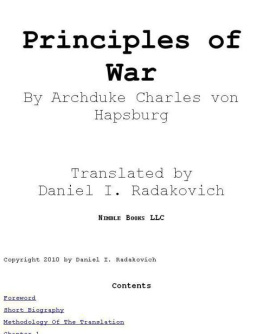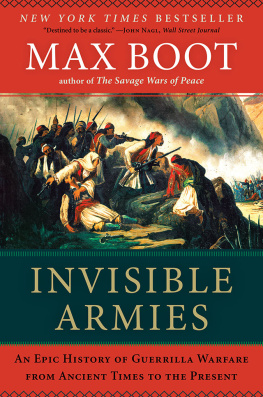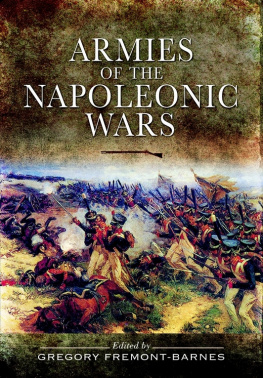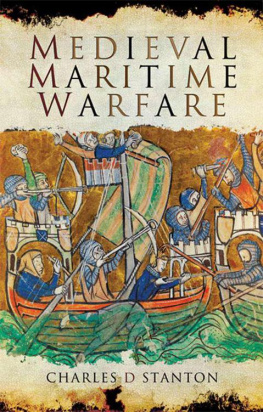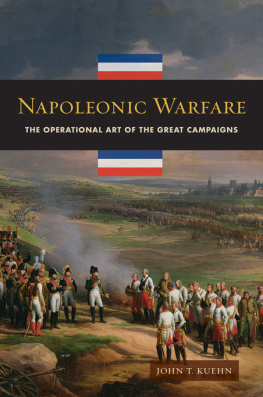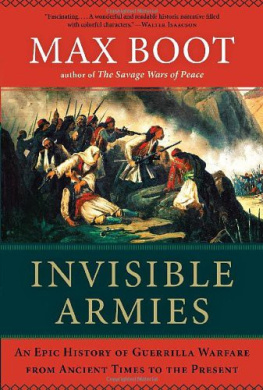Principles of War
By Archduke Charles von Hapsburg
Translated by
Daniel I. Radakovich
N IMBLE B OOKS LLC
Copyright 2010 by Daniel I. Radakovich
Contents
F OREWORD
It is always something of a puzzle how to enlist the interest of the hapless reader in a foreword . For if the author has anything of value to say, it is more apt to be ignored or lost there than if properly placed in the concert of the body of the work; and if it is of no or little value, then why bother with it at all? Most of the time forewords seem to be devoted to dedications anyway. But there are times when the presence of a foreword is a useful thing, and that is when the work itself may be wrongly considered mere ephemera of historical curiosity value at best. Such is the case with this one, originally titled Grndstze der Hhenkriegsknst by the Napoleonic era's Archduke Charles von Hapsburg of Austria ... herein translated into English as Principles of War for simplicity's sake. A more literal translation could be Fundamentals for the Higher Warcraft.
In the field of military history, it is all too common to refer to ancient tomes of strategy and tactics for no better reason than idle curiosity, to picture to the author-and, if he is competent, his reader- the movements and actions that were undertaken by the sides in a particular battle or campaign to help them get to a finer understanding of what happened in the milieu of the period. All well and good, but esoteric surely for those whose interest goes beyond reconstructing the past. The work presented here is not one of generalizations for strategic thought or stratagems of war like those perused by any overly enamored of potential business applications. The world has recently seen practically every major writer on military strategy essayed to fit into preconceived molds for that sort of writer trying to validate all sorts of things the originator could not have possibly contemplated their work would be used to justify or illuminate. That does not mean that these forward-looking applications of past insight are without some value, but again clearly the value resides in whether or not the person reading it is concerned with the applied subject.
This work, which, although coming out under the auspices of the Archduke Charles was in effect a committee effort, it was an attempt to reassess what had gone wrong in recent years, to delineate what had gone right, and in what [in the appended chapter about the French wars] might need still to be re-evaluated. We see a period of transition in a major failed organization, which is seeking to requalify and revalidate its own tradition in new circumstances, by identifying earlier ways in which the perceived traditional wisdom had become warped or perverted out of the norm, and to recreate the past successes by a return to a fundamentals weltaanschaung. The book was created in the middle of the most critical period in the existence of that state, after some five successive failed campaigns that had seen it stripped of its most ancient title of Holy Roman Empire, and losing approximately a third of its territory and most of its prestige along the way. In the entirety of the catastrophe only one leader had come even close to an even match with the newly constituted but ancient foe, France, and that was Archduke Charles. He had beaten several of France's marshals and had performed creditably against their first teams of Bonaparte and Moreau. Indeed, a few years after composing this book, Charles was one of the few to win a battle against Napoleon at the height of his career. (His victory came at the place called by the French Essling but by Austrians Aspern, so the rest of the world often calls it by a hyphenated conjunction Aspern-Essling.) Months later Charles was decisively beaten at Wagram, but it was a damned close-run thing as a certain British leader of the period might have said.
Withal this is a loser's book. Its possession did not make the possessors able to win against superior forces, as reputedly was the result of Frederick the Great's Instructions --though the mere mystery of the rumor of the Instructions was a more valuable asset than their actual possession, just as the supposed keys to his success were mistakenly taken to be continuous parade ground drills. Le Grande Frdrique was above all a pragmatist, and often ignored what he himself had written in his earlier tome ... as indeed was Charles. Why, then, is there any use at all in looking at The Principles of War?
Well, for one thing, the winner of those conflicts-Napoleon- did not write a how to book.. The methods and procedures of Napoleonic France are not as clear-cut as the historian would like. Many writers from Jomini and Clausewitz to the lesser-known lights that Napoleon critiqued on St. Helena and the American distillers like Winfield Scott, Henry Halleck and Hardee, attempted to create something like a recipe book of how the armies of L'empereur achieved their successes. Even the best of these authors, who had fullest access to the several drill manuals and tactical tomes and volumes and campaign overviews, kept coming up with inconsistencies and confusion.
Principles of War is a primer for generals. It is perhaps difficult to believe that one would get to such a high command level without already knowing the contents, but the peculiarities of the multi-lingual multi-national forces of the Austrian realm made this remedial work not only desirable but a necessity. Of all the challenges in competition through teamwork, be they war, sport or business, the chief difficulty is to get everyone on the same page. A common melody sets the tune from which any riffs or variations can be undertaken.
Principles of War is meant to give the basics of the art of war in the same way that an art book talks about how to draw a line to perspective. As a primer, it never attained the higher repute at the time of the more theoretical geometrically-nuanced proofs of Jomini or the Kant-like philosophical musings of Clausewitz on the nature of war itself. However, unlike the German sage's The Art of War, the Principles was at least completed. It enjoyed a fair vogue in the period immediately after the Napoleonic era, coming out in Germanic and French versions, one copy of which is known to have travelled with a British general[Charles Napier] in campaigns upon the Indian subcontinent. The Austrian losses at Solerfino in 1859 and Koniggrtz-Sadowa in 1866, where presumably they followed these precepts, most likely led to the demise and disuse of Principles... though Benedek disdained to follow several of Charles' caveats on how to march and prepare for battle in his preliminary campaign.
En fine, what is the utility of perusing this work? Principles? It is an example of how in a field of intense and deadly competition, in the middle of crisis, an attempt to find an answer was found. It may have been imperfect. It may not have been the best answer. But it was an answer, and it served well enough to take the Austrian army through the next eight years of war (1807-15) with more creditable results and less friction and ineptitude than theretofore. It is one of life's little victories over entropy, mistake, error and all the ills the Fall of Man lays us heirs to. Whether the causative factor be termed Satan or Murphy its goal is the same, and it must always be fought.
S HORT B IOGRAPHY
Archduke Charles von Hapsburg's full name in German was Karl Ludwig Johann Josef Lorenz, Erzeherzog von sterreich und Herzog von Teschen. He was born in Florence, Italy on September 5th, 1771 and died on April 30th, 1847 in Vienna, Austria. He had a notable career as an army commander in the French Revolutionary and ensuing Napoleonic Wars, beginning as a brigade commander at 21, achieving army command at 25, defeating commanders as diverse as Jourdan, Moreau, Bonaparte, Massna, and Ney, and though at Teining Bernadotte gave him a check, the future Swede was forced to withdraw later. Charles also had his own share of defeats as well, but he was clearly on their level in strategic and tactical leadership. He was diagnosed with epilepsy at an early age, although it was at most an exceedingly mild form and may well have been another nervous disorder. There is no reliable record of this condition having any adverse effects upon his generalship, though as may be understood it at times was blamed for his few failures. Ill health of another sort is credited with his departure from the military in 1798, but it may have been politically engendered rather than physiologically. He was reportedly short, around 5' in height, which makes him one of the few people Napoleon topped in that area ["Boney" was 5' 6 1/2the traditional 5'2 is a mistransliteration of French pre-metric measurement into English standard ]. After Wagram Charles was retired from commandpresumably because he was against the Napoleonic alliance politically, more practically his disgust at losing Wagram had caused him to lose it threatening decimation of the ranks[killing one in ten], etc.except for a short period when he commanded the fortress of Mainz after the Hundred Days campaign in 1815. Had Napoleon managed to defeat Blcher and Wellington the odds are that Schwarzenberg and Barclay de Tolly would have met him next, not the old sparring partner in Italy and Bavaria the Archduke Charles. Charles married later in 1815 and had several children, one of whom, Archduke Albrecht, was regarded as an excellent general in his own right, commanding in chief in Venetia against the Italians in 1866. Later Charles inherited the duchy of Saxe-Teschen from his childless aunt's husband; they had fostered him as a young man, as Charles' father the future Kaiser und knig Leopold had a large brood and took pity on his sibling's childless state.
Next page
